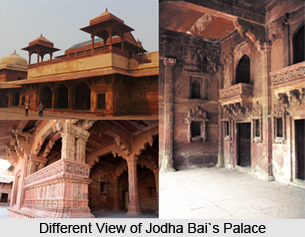 Jodha Bai`s Palace inside Fatehpur Sikri was the residence of the emperor`s principal wives and not Jodha Bai`s personal palace as popularly claimed. Zenana life was largely communal and this complex, also known as Shabistan-i-Iqbal, was designed to provide space, both private and shared, to women living there.
Jodha Bai`s Palace inside Fatehpur Sikri was the residence of the emperor`s principal wives and not Jodha Bai`s personal palace as popularly claimed. Zenana life was largely communal and this complex, also known as Shabistan-i-Iqbal, was designed to provide space, both private and shared, to women living there.
It is the largest and most important of the buildings in the Haram Sara with a single entrance, facing east across a wide paved courtyard. From the entrance of the palace a screened viaduct ran across the road behind Maryam`s House; and joined the top of the cloister facing the Daftar Khana. Through it, Akbar had easy and private access from his Khwabgah to every palace in the Haram Sara.
The palace appears solemn and massive; the balconies at the corners allowed the residents a view of the outside but kept the interiors well concealed. The principal entrance, once guarded by eunuchs, is double-storied. Jodha Bai`s Palace is a good place to study the different architectural styles in the buildings of Fatehpur Sikri.
The bases, columns, and capitals in the central rooms are carved in the Hindu manner and the plan draws inspiration from Rajput traditions as against the more Islamic pattern of other buildings. The azure-blue ribbed roof of the upper rooms at the northern and southern ends stand out amidst the dull and weathered kiosks.
Against the northern exterior wall of Jodha Bai`s Palace is the Hawa Mahal or Wind Palace. The first storey, supported on square columns in double rows, is open; the second is closed with beautiful stone screens. From the eastern and western sides of the central northern room, staircases rise to the screened first storey. One can walk across from the Hawa Mahal to the Hathiya Pol through a screened viaduct which has the only surviving arabesque stone screen in Fatehpur.
This article is a stub. You can enrich by adding more information to it. Send your Write Up to content@indianetzone.com



















